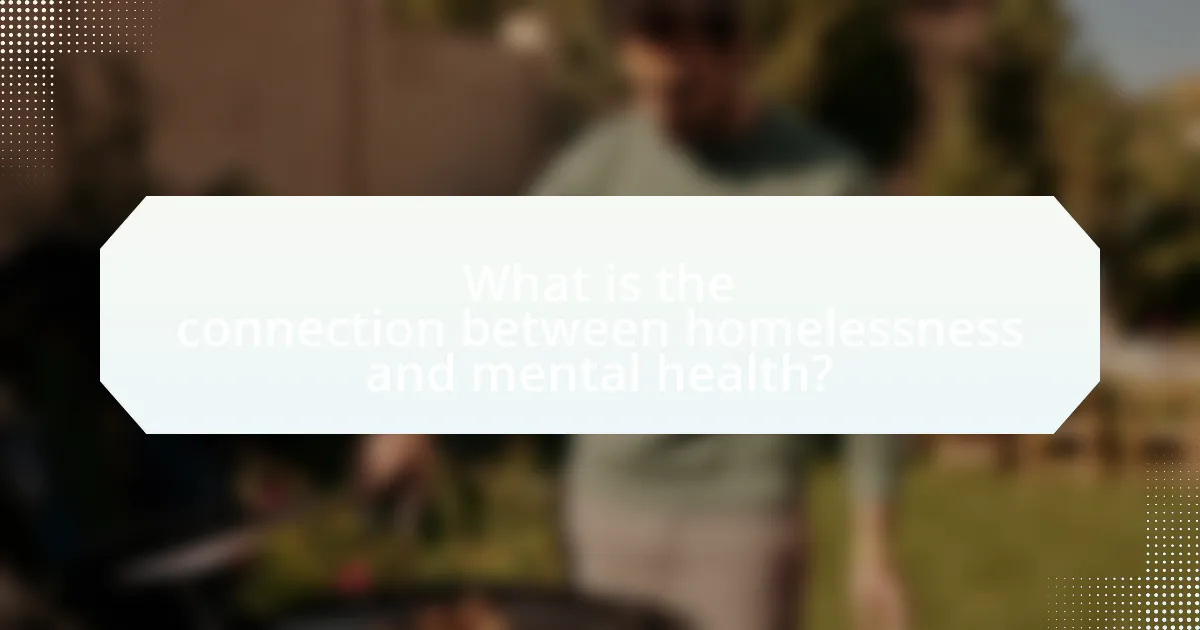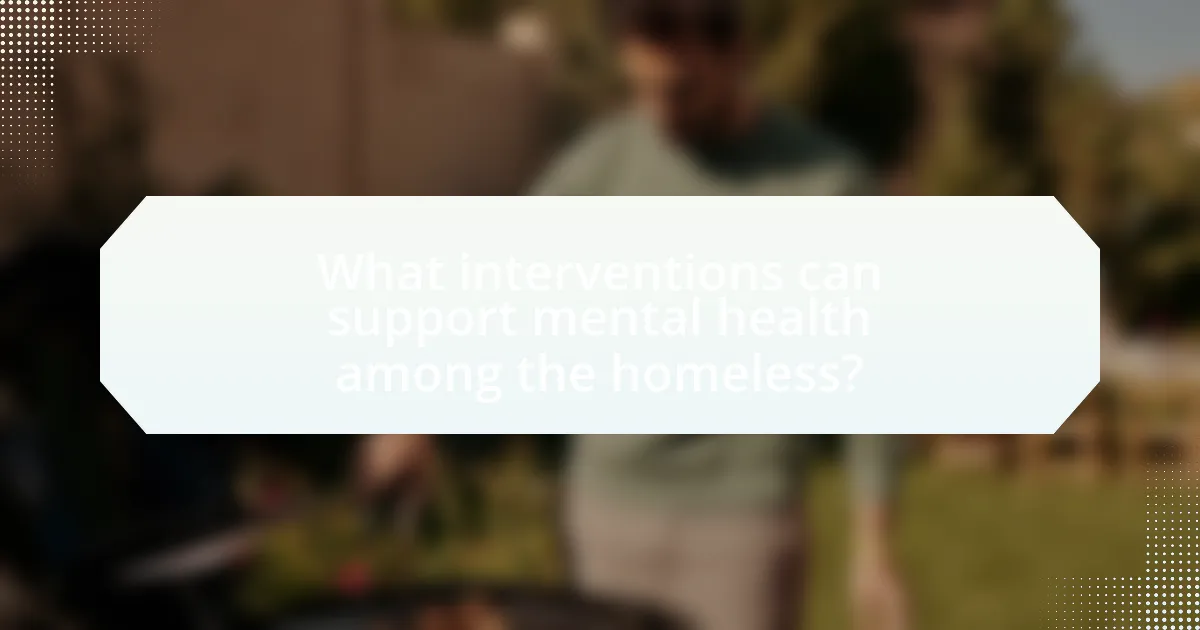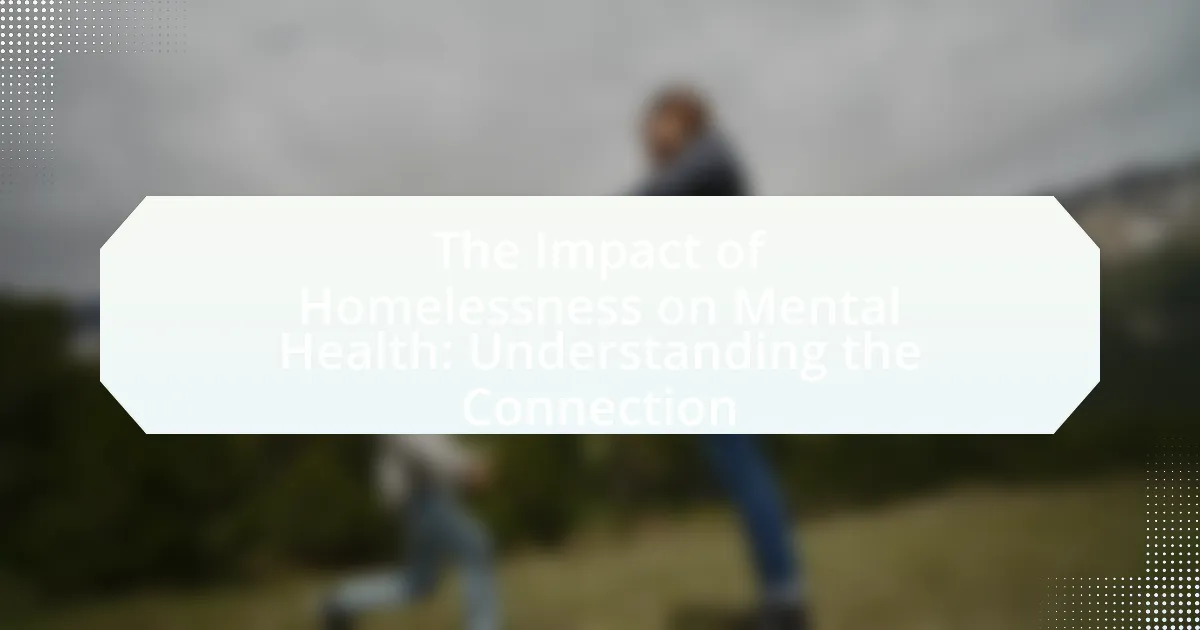The article examines the significant connection between homelessness and mental health, highlighting that individuals experiencing homelessness face disproportionately high rates of severe mental health disorders, such as schizophrenia and bipolar disorder. It discusses how factors like social isolation, lack of access to healthcare, and exposure to violence exacerbate mental health issues and create barriers to treatment. The article also explores the cyclical nature of homelessness and mental health challenges, the societal implications of untreated mental health conditions among the homeless, and effective interventions that can improve mental health outcomes, including integrated healthcare approaches and community support programs. Understanding these dynamics is crucial for developing targeted strategies to address both homelessness and mental health needs.

What is the connection between homelessness and mental health?
Homelessness significantly impacts mental health, as individuals experiencing homelessness often face increased rates of mental health disorders. Research indicates that approximately 25% to 50% of homeless individuals suffer from severe mental illnesses, such as schizophrenia or bipolar disorder, compared to about 5% of the general population. The stressors associated with homelessness, including social isolation, lack of access to healthcare, and exposure to violence, exacerbate existing mental health issues and can lead to the development of new disorders. Furthermore, the cyclical nature of homelessness and mental health challenges creates barriers to obtaining stable housing and necessary treatment, perpetuating the struggle for both mental well-being and housing stability.
How does homelessness affect mental health outcomes?
Homelessness significantly worsens mental health outcomes, leading to increased rates of conditions such as depression, anxiety, and post-traumatic stress disorder (PTSD). Studies indicate that individuals experiencing homelessness are more likely to suffer from severe mental health issues due to factors like chronic stress, social isolation, and lack of access to healthcare. For instance, a study published in the American Journal of Psychiatry found that nearly 30% of homeless individuals have a serious mental illness, compared to about 5% in the general population. Additionally, the National Coalition for the Homeless reports that homelessness exacerbates existing mental health conditions and creates barriers to treatment, further deteriorating mental well-being.
What specific mental health disorders are prevalent among the homeless population?
Specific mental health disorders prevalent among the homeless population include schizophrenia, bipolar disorder, major depressive disorder, and post-traumatic stress disorder (PTSD). Research indicates that approximately 25% of homeless individuals experience severe mental illness, with schizophrenia being one of the most common diagnoses. A study published in the American Journal of Psychiatry found that 30% of homeless individuals have a mood disorder, while PTSD affects around 30% of the homeless population, often linked to traumatic experiences prior to or during homelessness. These statistics highlight the significant mental health challenges faced by individuals experiencing homelessness.
How does the duration of homelessness influence mental health conditions?
The duration of homelessness significantly exacerbates mental health conditions. Prolonged exposure to the stressors associated with homelessness, such as instability, lack of access to healthcare, and social isolation, can lead to the development or worsening of mental health disorders, including depression, anxiety, and post-traumatic stress disorder (PTSD). Research indicates that individuals experiencing homelessness for extended periods are more likely to report severe mental health issues; for instance, a study published in the American Journal of Psychiatry found that long-term homelessness is correlated with a higher prevalence of psychiatric disorders compared to those who experience shorter episodes of homelessness. This relationship underscores the critical need for targeted mental health interventions for individuals facing prolonged homelessness.
Why is understanding this connection important?
Understanding the connection between homelessness and mental health is crucial because it informs effective interventions and policy decisions. Research indicates that individuals experiencing homelessness are at a significantly higher risk for mental health disorders, with studies showing that approximately 25% of homeless individuals suffer from severe mental illness, compared to just 5% in the general population. Recognizing this connection allows for targeted support services that address both housing instability and mental health needs, ultimately improving outcomes for affected individuals and reducing the societal costs associated with untreated mental health issues.
What are the societal implications of mental health issues in the homeless population?
Mental health issues in the homeless population lead to significant societal implications, including increased healthcare costs, higher rates of crime, and diminished public safety. The presence of untreated mental health conditions among homeless individuals often results in frequent emergency room visits and hospitalizations, which can strain public health resources. For instance, a study by the National Alliance to End Homelessness found that individuals experiencing homelessness and mental illness are more likely to engage in behaviors that result in legal issues, contributing to higher incarceration rates. Furthermore, the stigma surrounding mental health can perpetuate discrimination against the homeless, hindering their access to services and support systems. This cycle not only affects the individuals but also impacts community cohesion and overall societal well-being.
How can addressing mental health improve outcomes for homeless individuals?
Addressing mental health can significantly improve outcomes for homeless individuals by facilitating access to necessary support services, which can lead to stable housing and better overall well-being. Research indicates that approximately 30% of homeless individuals experience serious mental illness, and addressing these mental health issues can reduce the likelihood of recurring homelessness. For example, programs that integrate mental health care with housing assistance have shown to decrease homelessness rates by up to 80%, as evidenced by studies conducted by the National Alliance to End Homelessness. By providing mental health resources, individuals are more likely to engage in treatment, maintain housing stability, and improve their quality of life.

What are the underlying factors linking homelessness and mental health?
The underlying factors linking homelessness and mental health include socioeconomic instability, lack of access to healthcare, and social isolation. Socioeconomic instability often leads to stress and anxiety, which can exacerbate existing mental health conditions or contribute to the development of new ones. Lack of access to healthcare prevents individuals from receiving necessary mental health treatment, further deteriorating their psychological well-being. Social isolation, a common experience among homeless individuals, can lead to feelings of loneliness and depression, compounding mental health issues. Studies indicate that approximately 25% of homeless individuals experience severe mental illness, highlighting the critical intersection of these factors.
How do socioeconomic factors contribute to both homelessness and mental health issues?
Socioeconomic factors significantly contribute to both homelessness and mental health issues by creating conditions that limit access to essential resources and support systems. Individuals facing poverty, unemployment, and lack of affordable housing are at a higher risk of becoming homeless, which in turn exacerbates mental health problems due to increased stress, isolation, and lack of stability. For instance, a study by the National Alliance to End Homelessness found that 30% of homeless individuals reported mental health issues, often stemming from the stressors associated with their socioeconomic status. Additionally, limited access to healthcare services and social support networks further compounds these mental health challenges, creating a cycle where socioeconomic disadvantage leads to homelessness, which then worsens mental health outcomes.
What role does poverty play in exacerbating mental health conditions?
Poverty significantly exacerbates mental health conditions by increasing stressors such as financial instability, lack of access to healthcare, and social isolation. Individuals living in poverty often experience chronic stress, which can lead to anxiety and depression. Research indicates that people in low-income brackets are more likely to suffer from mental health disorders; for instance, a study published in the American Journal of Psychiatry found that individuals with lower socioeconomic status have a higher prevalence of mood and anxiety disorders compared to their wealthier counterparts. Additionally, the lack of resources in impoverished communities limits access to mental health services, further worsening the situation.
How does lack of access to healthcare impact mental health among the homeless?
Lack of access to healthcare significantly deteriorates mental health among the homeless. Without adequate medical services, individuals experiencing homelessness often face untreated mental health conditions, leading to increased symptoms of anxiety, depression, and other psychological disorders. Research indicates that approximately 30% of homeless individuals suffer from serious mental illness, and the absence of healthcare exacerbates these issues by preventing access to necessary treatments and medications. Furthermore, the stress of living without stable housing compounds mental health challenges, creating a cycle of worsening conditions that are difficult to escape without proper healthcare support.
What environmental factors influence mental health in homeless individuals?
Environmental factors significantly influence the mental health of homeless individuals, with key elements including exposure to violence, lack of stable housing, and inadequate access to healthcare. Research indicates that homeless individuals often face high rates of trauma and victimization, which can exacerbate mental health issues. For instance, a study published in the American Journal of Public Health found that 60% of homeless individuals reported experiencing violence, leading to increased rates of anxiety and depression. Additionally, the absence of stable housing creates chronic stress, which is linked to various mental health disorders. Furthermore, limited access to healthcare services prevents homeless individuals from receiving necessary mental health support, compounding their challenges. These environmental factors collectively contribute to the deterioration of mental health among homeless populations.
How does exposure to violence and trauma affect mental health?
Exposure to violence and trauma significantly deteriorates mental health, leading to conditions such as post-traumatic stress disorder (PTSD), anxiety, and depression. Research indicates that individuals exposed to such adverse experiences often exhibit heightened stress responses, which can disrupt emotional regulation and cognitive functioning. For instance, a study published in the Journal of Traumatic Stress found that nearly 70% of individuals experiencing homelessness reported a history of trauma, which correlates with increased rates of mental health disorders. This evidence underscores the profound impact that violence and trauma have on mental well-being, particularly among vulnerable populations like the homeless.
What is the impact of social isolation on mental well-being for the homeless?
Social isolation significantly deteriorates the mental well-being of homeless individuals. Research indicates that social isolation leads to increased rates of depression, anxiety, and suicidal ideation among this population. A study published in the American Journal of Public Health found that homeless individuals experiencing social isolation are more likely to report poor mental health outcomes, with 60% of participants indicating feelings of loneliness and despair. This lack of social support exacerbates existing mental health issues and hinders access to necessary resources, further entrenching the cycle of homelessness and mental health decline.

What interventions can support mental health among the homeless?
Interventions that can support mental health among the homeless include access to mental health services, housing-first programs, and integrated healthcare approaches. Access to mental health services provides individuals with necessary therapy and medication management, which are crucial for addressing mental health disorders prevalent in this population. Housing-first programs have shown effectiveness by providing stable housing without preconditions, leading to improved mental health outcomes; studies indicate that individuals in such programs experience reduced psychiatric symptoms and increased engagement in treatment. Integrated healthcare approaches combine mental health care with primary health services, ensuring comprehensive support that addresses both physical and mental health needs, which is essential given the high rates of comorbid conditions among the homeless.
How can mental health services be effectively integrated into homelessness support programs?
Mental health services can be effectively integrated into homelessness support programs by establishing collaborative frameworks that combine housing assistance with mental health care. This integration can be achieved through co-locating mental health professionals within shelters and transitional housing facilities, ensuring that individuals experiencing homelessness receive immediate access to mental health assessments and treatment. Research indicates that programs like the Housing First model, which prioritizes stable housing before addressing mental health issues, have shown significant success in improving mental health outcomes among homeless populations. A study published in the American Journal of Psychiatry found that participants in Housing First programs experienced a 50% reduction in psychiatric symptoms compared to those in traditional treatment settings. This evidence supports the effectiveness of integrating mental health services into homelessness support programs to enhance overall well-being and stability for individuals facing homelessness.
What types of mental health treatments are most effective for homeless individuals?
Assertive community treatment (ACT) and integrated dual disorders treatment (IDDT) are the most effective mental health treatments for homeless individuals. ACT provides comprehensive, community-based psychiatric treatment, which has been shown to reduce hospitalization rates and improve overall functioning among homeless populations. IDDT addresses both mental health and substance use disorders simultaneously, leading to better outcomes in recovery and stability. Research indicates that these approaches significantly enhance engagement in treatment and improve quality of life for homeless individuals, as evidenced by studies such as the one published in the American Journal of Psychiatry, which highlights the effectiveness of ACT in reducing symptoms and improving housing stability among this vulnerable group.
How can outreach programs improve access to mental health care?
Outreach programs can improve access to mental health care by actively engaging underserved populations, particularly those experiencing homelessness. These programs facilitate connections between individuals and mental health services by providing education, resources, and direct support in community settings. For instance, a study published in the American Journal of Psychiatry found that outreach initiatives significantly increased the likelihood of individuals with mental health issues receiving treatment, demonstrating a 30% rise in service utilization among participants. By addressing barriers such as stigma, lack of transportation, and limited awareness of available services, outreach programs effectively bridge the gap between vulnerable populations and essential mental health care.
What role do community organizations play in supporting mental health for the homeless?
Community organizations play a crucial role in supporting mental health for the homeless by providing essential services such as counseling, outreach programs, and access to healthcare. These organizations often serve as the first point of contact for homeless individuals, offering mental health assessments and connecting them to necessary resources. For instance, studies indicate that community-based mental health programs can reduce symptoms of mental illness and improve overall well-being among homeless populations. Additionally, organizations like the National Alliance to End Homelessness report that integrated services, which combine mental health support with housing assistance, significantly enhance recovery outcomes.
How can peer support programs enhance mental health outcomes?
Peer support programs enhance mental health outcomes by providing individuals with shared experiences and emotional support, which fosters a sense of belonging and reduces feelings of isolation. Research indicates that participants in peer support programs often report improved mental health symptoms, increased self-efficacy, and greater engagement in treatment. For instance, a study published in the Journal of Mental Health found that peer support can lead to a 20% reduction in depressive symptoms among participants, demonstrating the effectiveness of these programs in promoting recovery and resilience.
What best practices should be implemented in community-based interventions?
Best practices in community-based interventions for addressing homelessness and its impact on mental health include fostering collaboration among stakeholders, ensuring cultural competence, and utilizing evidence-based approaches. Collaboration among local organizations, government agencies, and community members enhances resource sharing and creates a more comprehensive support system. Cultural competence ensures that interventions are tailored to the diverse backgrounds of individuals experiencing homelessness, which is crucial for effective engagement and support. Evidence-based approaches, such as the Housing First model, have been shown to improve mental health outcomes by providing stable housing as a foundation for recovery. These practices are supported by research indicating that integrated services and community involvement lead to better mental health outcomes for homeless populations.
What practical steps can be taken to address mental health issues in the homeless population?
To address mental health issues in the homeless population, implementing comprehensive outreach programs is essential. These programs should include mobile mental health clinics that provide on-site assessments, therapy, and medication management directly in areas where homeless individuals congregate. Research indicates that such initiatives can significantly improve access to mental health services; for example, a study published in the American Journal of Psychiatry found that mobile outreach led to a 30% increase in treatment engagement among homeless individuals with mental health disorders. Additionally, integrating mental health services with housing assistance programs can create a stable environment conducive to recovery, as evidenced by the success of the Housing First model, which has shown to reduce psychiatric symptoms and improve overall well-being in homeless populations.

Leave a Reply